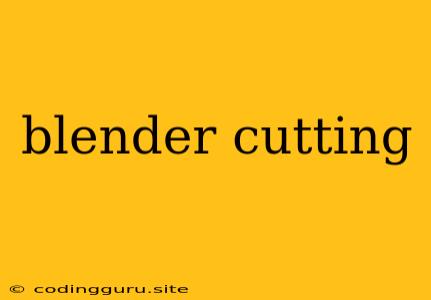Mastering the Art of Blender Cutting: Techniques and Tips for Smooth Edits
Blender, the powerful open-source 3D creation suite, offers a multitude of tools for sculpting your digital creations. Among these tools, blender cutting plays a crucial role in shaping and refining your models. But how do you navigate the nuances of blender cutting to achieve the desired results?
Blender cutting involves precisely severing and modifying your 3D mesh, enabling you to add intricate details, remove unwanted geometry, and create clean, well-defined edges. This process involves a combination of tools and techniques, making it a fundamental skill for any aspiring 3D artist.
Here's a guide to help you understand the different aspects of blender cutting and master its techniques:
Understanding the Basics
1. What are the tools involved in blender cutting?
Blender offers several tools for cutting your models, each with its own strengths and weaknesses. The most commonly used tools include:
- Knife Tool: This tool allows you to slice through your mesh, creating new edges and faces.
- Loop Cut and Slide: This tool lets you create loops of edges, which can be used to precisely divide a mesh into segments.
- Edge Slide: This tool enables you to manipulate the position of an edge within a mesh, allowing you to smooth out curves or create unique shapes.
2. How do you use the Knife Tool effectively?
The Knife Tool is versatile but requires a bit of practice. Here's how to use it:
- Select the Knife Tool: Choose it from the Tools panel or press "K" on your keyboard.
- Select the "Cut Through" option: This setting ensures that your cut goes through the entire mesh.
- Begin your cut: Click and drag the mouse on your mesh to create a cut line.
- Use the Ctrl key for precision: Press and hold Ctrl while cutting to constrain the movement to straight lines.
- Finish your cut: Right-click to confirm your cut.
3. How do you leverage the Loop Cut and Slide tool?
The Loop Cut and Slide tool is ideal for creating precise loops of edges, especially when working with complex surfaces.
- Select the tool: Press "Ctrl + R" on your keyboard.
- Choose the desired number of loop cuts: Hover your mouse over the area you want to cut and scroll your mouse wheel to adjust the number of loops.
- Position the loops: Left-click to confirm the placement of the loops.
- Slide the loops: You can adjust the position of the loops by dragging them with your mouse.
Mastering Advanced Techniques
1. How do you cut a mesh with precision?
For delicate cutting, you can utilize the Snap to Vertex and Snap to Edge options. These settings help ensure your cuts align perfectly with existing geometry, leading to cleaner results.
2. How do you create smooth curves with blender cutting?
Blender provides several methods for smoothing out curves after cutting.
- Bevel Tool: This tool adds rounded edges to your cuts, creating a smoother appearance.
- Subdivision Surface Modifier: This modifier smooths the entire mesh, including your newly created cuts.
Blender Cutting in Practice
1. What are some common applications of blender cutting?
Blender cutting finds extensive use in various 3D modeling workflows, including:
- Creating intricate details: Cutting and sculpting allow for the addition of fine features like buttons, zippers, and textures.
- Removing unwanted geometry: Cutting enables you to clean up a model, remove unnecessary parts, and improve its overall shape.
- Splitting a model: Cutting allows you to divide a model into separate parts, making it easier to manipulate or animate.
2. What are some tips for efficient blender cutting?
- Isolate your work area: Select only the parts you need to cut, making the process more efficient.
- Practice regularly: The more you use the cutting tools, the more comfortable you'll become with their nuances.
- Experiment with different tools: Try out different cutting tools to find the one that suits your specific needs.
- Use a combination of techniques: Combining different cutting tools and techniques can help you achieve complex shapes and details.
Conclusion
Blender cutting is a vital skill for creating high-quality 3D models. By understanding the different tools and techniques involved, you can effectively shape and refine your digital creations, leading to more detailed and visually appealing results. Remember to practice regularly and experiment with different approaches to master the art of blender cutting and unlock the full potential of this powerful software.
